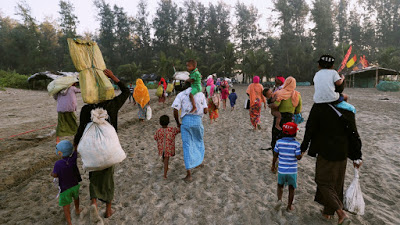Five Questions About Sexual Violence in the Rohingya Crisis
 |
| Jamille Bigio – November 9, 2017 |
What were the experiences of the Rohingya women and girls you interviewed?
Almost thirty of the Rohingya women and girls I interviewed were brutally gang-raped by the Myanmar military and then had to walk for days to reach safety in Bangladesh. When asked to describe the journey, one woman said “there was just so much pain,” and burst into tears recalling the agony of walking on very serious injuries, with very little to eat, having lost everything.
Rape was one of the ways that the Myanmar military conducted their ethnic cleansing of the Rohingya. Many of the women I spoke with suffered at the hands of six or seven perpetrators. And it was violent: many also had been stabbed, shot, or brutally beaten. In one case, a 15-year-old girl was ruthlessly dragged on the ground for some 50 feet, tied to a tree, and then raped by 10 Myanmar soldiers. Many of the women I spoke with also witnessed their families and children being murdered. The pain and suffering these victims have experienced is unfathomable.
It was striking that in many cases, the day that their villages were burned was just the culmination of many days, weeks, or even months of harassment by Myanmar security forces. This didn’t look like just a spontaneous thing: we documented patterns of sexual harassment and abuse that stretched back for weeks before the major attack. We also documented rapes and other forms of sexual violence against Rohingya women and girls between October and December of 2016.
What is the situation for female refugees once they reach Bangladesh? Have the survivors of sexual violence had access to the care they need?
The scale and speed of this humanitarian crisis is overwhelming. Every day there are more humanitarian organizations working there, and the access to services increases. But the women I spoke with reported feeling too ashamed to confide in their doctors. Often they are treated for emergency medical services in makeshift tents, without privacy or confidentiality to report rape.
In addition, many of the women and girls I interviewed do not know what services are available to them. In Myanmar, they never had access to adequate health care: they lived far away from medical services and sometimes faced military obstruction in their efforts to receive care. Now, because of this history of abuse, they may not seek care in the camps because they don’t know what’s available.
Humanitarian organizations need to invest more in outreach efforts. It seems to help when community workers go into the camps, meet leaders, meet women, and help to connect survivors to the services available.
How can the situation be improved for refugee Rohingya women and girls?
Establishing and expanding women-friendly spaces is critical to ameliorating the vulnerability of Rohingya women and girls. While Rohingya men have access to mosques and affiliated community areas in the refugee camps, women lack a secure gathering space. The Bangladeshi government should work with donors to organize spaces where women can easily gather, receive medical care and psychosocial support in privacy, access economic opportunities, and ultimately feel safe.
Although humanitarian organizations are doing their best to meet basic minimum standards for prevention of sexual violence, the poorly structured refugee camps, with their limited oversight, lack of lighting at night, and proximity from a main road can be breeding grounds for chaos. The camp is a protection disaster waiting to happen.
What about justice for the survivors of sexual violence?
The use of sexual violence in Myanmar should be investigated as a crime against humanity. Experts should document the stories of survivors and the impact of this violence.
And then there’s the issue of the Rohingya women and girls who have been raped in Bangladesh. According to a Bangladeshi organization, in two cases where they have supported Rohingya girls who have been raped in Bangladesh, judges refused to tell police to open investigations simply because a Rohingya person was involved.
But more broadly, it’s difficult to imagine how victims will heal given the uncertainties of their future. They don’t know if they’re going to be able to stay in Bangladesh, or whether they may be pushed to go back to a country where women faced horrific persecution.
How should the United States and the United Nations respond?
While many people have expressed outrage about the Rohingya crisis, this has not translated into much action. The United Nations Security Council should approve sanctions, including an arms embargo, and individual sanctions like asset freezes and travel bans on specific individuals responsible for these atrocities. There should be more pressure on the Myanmar government to ensure humanitarian access to the Rohingya still in Myanmar. Countries around the world should rethink their policies toward Myanmar: given the appalling nature of this crisis, the attitude that Myanmar was moving in the right direction is no longer appropriate.


